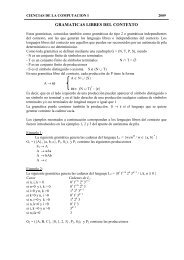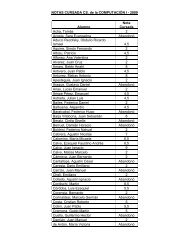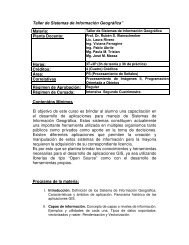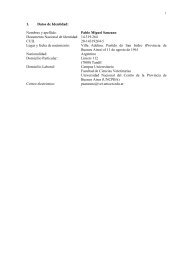Libro de Resúmenes / Book of Abstracts (Español/English)
Libro de Resúmenes / Book of Abstracts (Español/English)
Libro de Resúmenes / Book of Abstracts (Español/English)
You also want an ePaper? Increase the reach of your titles
YUMPU automatically turns print PDFs into web optimized ePapers that Google loves.
Resumenes 131<br />
An age-structured finite element mo<strong>de</strong>l for the population<br />
dynamics <strong>of</strong> intertidal barnacles<br />
The majority <strong>of</strong> marine species have a complex life cycle where the<br />
adult phase is prece<strong>de</strong>d by a planktonic larval phase that lives and feeds in<br />
the coastal waters for a few days to a few months, <strong>de</strong>pending on the<br />
species [1]. The dynamics <strong>of</strong> the adult phase is strongly influenced by the<br />
transport processes (advection and eddy diffusion) in the water column that<br />
affect the planktonic larvae (pre-competency and competency stages). The<br />
biological value <strong>of</strong> recognizing the correlation between transport processes<br />
in the water and coastal recruitment motivates the <strong>de</strong>velopment <strong>of</strong> mo<strong>de</strong>ls<br />
for the population dynamics, which combine oceanographic and biological<br />
processes.<br />
In the work presented by Roughgar<strong>de</strong>n et al. [1], and exten<strong>de</strong>d later<br />
in [2, 3], the population dynamics <strong>of</strong> a marine organism that inhabits the<br />
rocky intertidal zone <strong>of</strong> central California (Balanus glandula) was mo<strong>de</strong>led<br />
taking into account the upwelling event in the region. They used an one-<br />
and two-dimensional standard finite difference numerical mo<strong>de</strong>l to solve the<br />
problem. More recently, Gaylor and Gaines [4] exten<strong>de</strong>d that work<br />
introducing in the two-dimensional finite-difference mo<strong>de</strong>l four simple<br />
representations <strong>of</strong> circulation patterns associated with biogeographic<br />
boundaries. They also inclu<strong>de</strong>d two additional age stages in the mo<strong>de</strong>l.<br />
In this work, the oceanographic processes are coupled with an agestructured<br />
finite element mo<strong>de</strong>l for barnacle Balanus glandula. Besi<strong>de</strong>s the<br />
larval competency and pre-competency stages, the age-structured mo<strong>de</strong>l<br />
inclu<strong>de</strong>s the non-reproducing juveniles and reproducing adults stages. The<br />
two-dimensional finite element mo<strong>de</strong>l proposed to solve this problem is a<br />
next step toward linking populational dynamics mo<strong>de</strong>ls to numerical<br />
circulation mo<strong>de</strong>ls. Besi<strong>de</strong>s introducing a more realistic life cycle, it uses an<br />
accurate and stable finite element method for reaction-convection-diffusion<br />
problems that allows flexibility in <strong>de</strong>aling with complex domains, boundary<br />
conditions and it is easily combined with an adaptive mesh procedure. From<br />
discrete data on the real velocity field, in this work also we <strong>de</strong>velop a<br />
consistent methodology for the representation <strong>of</strong> this field in the domain,<br />
which is assimilated to the transport mo<strong>de</strong>l previously <strong>de</strong>veloped [5]. These<br />
features allow investigating how barnacle population might respond to a<br />
variety <strong>of</strong> physical changes in the environment. Many scenarios are<br />
simulated in or<strong>de</strong>r to <strong>de</strong>monstrate the features <strong>of</strong> the mo<strong>de</strong>l (i. e., flow,<br />
larval transport and adults dynamics).<br />
Referencias<br />
[1] J. Roughgar<strong>de</strong>n, S. D. Gaines and H. P. Possingham, “Recruitment Dynamics<br />
in Complex Life Cycles”, Science, v.241, p.1460-1466, 1988.<br />
[2] H. P. Possingham and J. Roughgar<strong>de</strong>n, “Spatial population dynamics <strong>of</strong> a<br />
marine organism with a complex life cycle”, Ecology, v.71(3), p. 973-985, 1990.<br />
[3] S. E. Alexan<strong>de</strong>r and J. Roughgar<strong>de</strong>n, “Larval transport and population<br />
dynamics <strong>of</strong> intertidal barnacles: a coupled benthic/oceanic mo<strong>de</strong>l”, Ecological<br />
Monographs, v.66(3), p.259-275, 1996.



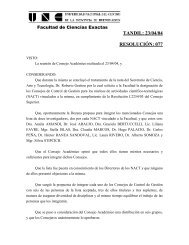
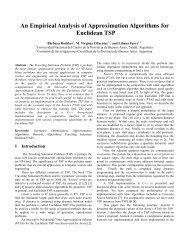
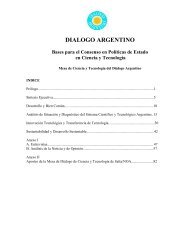
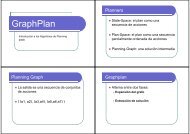
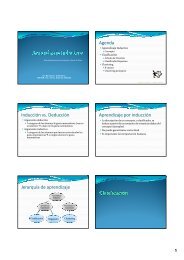
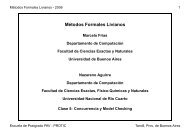
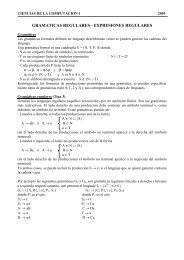

![Clase 13 [pdf]](https://img.yumpu.com/19616969/1/190x245/clase-13-pdf.jpg?quality=85)

